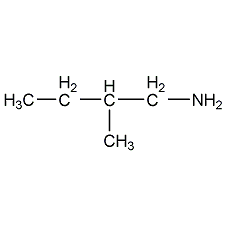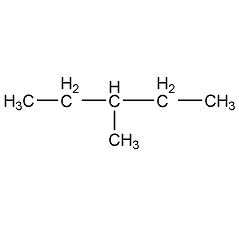
Structural formula
| Business number | 02AK |
|---|---|
| Molecular formula | C5H13N |
| Molecular weight | 87.16 |
| label |
2-Methyl-1-butylamine, 1-amino-2-methylbutane, 1-Amino-2-methylbutane, 2-Methyl-1-butylamine |
Numbering system
CAS number:96-15-1
MDL number:MFCD00008147
EINECS number:202-483-5
RTECS number:None
BRN number:1718806
PubChem number:24853176
Physical property data
1. Properties: colorless liquid.
2. Density (g/mL, 20?): 0.738
3. Relative vapor density (g/mL, air=1): Undetermined
4. Melting point (ºC): Undetermined
5. Boiling point (ºC, normal pressure): 94-97
6. Boiling point (ºC, kPa): Undetermined
p>
7. Refractive index (n20D): 1.4116
8. Flash point (ºC ): 3
9. Specific optical rotation (º): Undetermined
10. Autoignition point or ignition temperature (ºC): Undetermined
11 . Vapor pressure (mmHg, ºC): Undetermined
12. Saturated vapor pressure (kPa, ºC): Undetermined
13. Heat of combustion (KJ/mol): Undetermined
14. Critical temperature (ºC): Undetermined
15. Critical pressure (KPa): Undetermined
16. Oil and water (octanol/water) Log value of distribution coefficient: Undetermined
17. Explosion upper limit (%, V/V): Undetermined
18. Explosion lower limit (%, V/V): Undetermined
19. Solubility: Undetermined
Toxicological data
None
Ecological data
None
Molecular structure data
1. Molar refractive index: 28.70
2. Molar volume (cm3/mol): 115.1
3. Isotonic specific volume (90.2K ): 257.4
4. Surface tension (dyne/cm): 25.0
5. Polarizability (10-24cm3): 11.38
Compute chemical data
1. Reference value for hydrophobic parameter calculation (XlogP): 1
2. Number of hydrogen bond donors: 1
3. Number of hydrogen bond acceptors: 1
4. Number of rotatable chemical bonds: 2
5. Number of tautomers: none
6. Topological molecule polar surface area 26
7. Number of heavy atoms: 6
8. Surface charge: 0
9. Complexity: 27.1
10. Number of isotope atoms: 0
11. Determine the number of atomic stereocenters: 0
12. Uncertain number of atomic stereocenters: 1
13. Determine the number of chemical bond stereocenters: 0
14. Number of uncertain chemical bond stereocenters: 0
15. Number of covalent bond units: 1
Properties and Stability
1. Exist in smoke.
Storage method
None
Synthesis method
None
Purpose
Used in organic synthesis.
extended-reading:https://www.bdmaee.net/high-quality-zinc-neodecanoate-cas-27253-29-8-neodecanoic-acid-zincsalt/extended-reading:https://www.bdmaee.net/c6h11no2/extended-reading:https://www.bdmaee.net/niax-c-323-tertiary-amine-catalyst-momentive/extended-reading:https://www.bdmaee.net/lupragen-n104-catalyst-ethylmorpholine-basf/extended-reading:https://www.newtopchem.com/archives/44333extended-reading:https://www.bdmaee.net/polyurethane-rigid-foam-catalyst-cas-15875-13-5-catalyst-pc41/extended-reading:https://www.newtopchem.com/archives/1087extended-reading:https://www.bdmaee.net/rc-catalyst-101-catalyst-cas99-95-6-rhine-chemical/extended-reading:https://www.bdmaee.net/pc-cat-np40-catalyst-trisdimethylaminopropylhexahydrotriazine/extended-reading:https://www.bdmaee.net/rc-catalyst-108-cas108-39-4-rhine-chemical/



